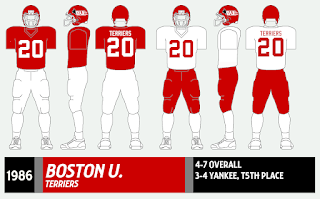Regrettably, I haven't done much with Delaware since this project began nearly six months ago. It's kind of a blessing and a curse to keep the same look for decades on end. On one hand, it's pretty cool that the 2014 Blue Hens don't look too different from the 1974 Hens, who don't look to different from the 1954 Hens; on the other, it takes a little fun out of the research. That said, Delaware's commitment to tradition -- and excellence -- is something to be commended.
Speaking of tradition ... In 1989, Delaware celebrated a century of football with a special "Celebrate the Tradition" patch worn on the left shoulder of the home jerseys. For the above graphic, I found a copy of the logo from the '89 UConn media guide, of all places.
The early '90s saw the Hens gradually lower their trademark thin-striped socks until the stripes were all but gone by '93. The number font flip-flopped between the longtime "Champion" font (slanted 2s, curved 7s) and a block number font, which won the day by '94.
 |
Delaware, with special 100th anniversary patch, takes on Maine in 1989.
From the 1990 Blue Hen yearbook. |
 |
The '91 Hens, from the '92 Blue Hen. That is one battle-scarred helmet on the center.
I wonder the initials on the front of the QB's helmet mean? |
There's a terrific book out there called 100 Plus: The Story of Delaware Football, which I'd recommend to anyone with even a passing interest in the program. You rarely see such a comprehensive volume devoted to an FCS program. In addition to a straightforward history, there are chapters devoted to their ground-and-pound philosophy, great games, short anecdotes, season-by-season records and even a trivia quiz. Check it out.











































.png)

.png)

.png)


